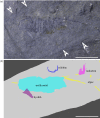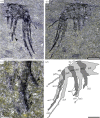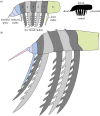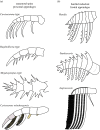A miniature Ordovician hurdiid from Wales demonstrates the adaptability of Radiodonta
- PMID: 32742697
- PMCID: PMC7353989
- DOI: 10.1098/rsos.200459
A miniature Ordovician hurdiid from Wales demonstrates the adaptability of Radiodonta
Abstract
Originally considered as large, solely Cambrian apex predators, Radiodonta-a clade of stem-group euarthropods including Anomalocaris-now comprises a diverse group of predators, sediment sifters and filter feeders. These animals are only known from deposits preserving non-biomineralized material, with radiodonts often the first and/or only taxa known from such deposits. Despite the widespread and diverse nature of the group, only a handful of radiodonts are known from post-Cambrian deposits, and all originate from deposits or localities rich in other total-group euarthropods. In this contribution, we describe the first radiodont from the UK, an isolated hurdiid frontal appendage from the Tremadocian (Lower Ordovician) Dol-cyn-Afon Formation, Wales, UK. This finding is unusual in two major aspects: firstly, the appendage (1.8 mm in size) is less than half the size of the next smallest radiodont frontal appendage known, and probably belonged to an animal between 6 and 15 mm in length; secondly, it was discovered in the sponge-dominated Afon Gam Biota, one of only a handful of non-biomineralized total-group euarthropods known from this deposit. This Welsh hurdiid breaks new ground for Radiodonta in terms of both its small size and sponge-dominated habitat. This occurrence demonstrates the adaptability of the group in response to the partitioning of ecosystems and environments in the late Cambrian and Early Ordovician world.
Keywords: Afon Gam Biota; Dol-cyn-Afon Formation; Hurdiidae; Lagerstätten; Ordovician; Radiodonta.
© 2020 The Authors.
Conflict of interest statement
The authors declare no competing interests.
Figures





Similar articles
-
Furongian (Jiangshanian) occurrences of radiodonts in Poland and South China and the fossil record of the Hurdiidae.PeerJ. 2021 Jul 23;9:e11800. doi: 10.7717/peerj.11800. eCollection 2021. PeerJ. 2021. PMID: 34386302 Free PMC article.
-
First report of paired ventral endites in a hurdiid radiodont.Zoological Lett. 2019 Jun 11;5:18. doi: 10.1186/s40851-019-0132-4. eCollection 2019. Zoological Lett. 2019. PMID: 31210962 Free PMC article.
-
A giant nektobenthic radiodont from the Burgess Shale and the significance of hurdiid carapace diversity.R Soc Open Sci. 2021 Sep 8;8(9):210664. doi: 10.1098/rsos.210664. eCollection 2021 Sep. R Soc Open Sci. 2021. PMID: 34527273 Free PMC article.
-
The origin of the animals and a 'Savannah' hypothesis for early bilaterian evolution.Biol Rev Camb Philos Soc. 2017 Feb;92(1):446-473. doi: 10.1111/brv.12239. Epub 2015 Nov 20. Biol Rev Camb Philos Soc. 2017. PMID: 26588818 Review.
-
On the eve of animal radiation: phylogeny, ecology and evolution of the Ediacara biota.Trends Ecol Evol. 2009 Jan;24(1):31-40. doi: 10.1016/j.tree.2008.07.015. Epub 2008 Oct 25. Trends Ecol Evol. 2009. PMID: 18952316 Review.
Cited by
-
Rapid growth in a large Cambrian apex predator.Natl Sci Rev. 2023 Nov 3;11(3):nwad284. doi: 10.1093/nsr/nwad284. eCollection 2024 Mar. Natl Sci Rev. 2023. PMID: 38312385 Free PMC article.
-
A Middle Ordovician Burgess Shale-type fauna from Castle Bank, Wales (UK).Nat Ecol Evol. 2023 May;7(5):666-674. doi: 10.1038/s41559-023-02038-4. Epub 2023 May 1. Nat Ecol Evol. 2023. PMID: 37127766
-
Furongian (Jiangshanian) occurrences of radiodonts in Poland and South China and the fossil record of the Hurdiidae.PeerJ. 2021 Jul 23;9:e11800. doi: 10.7717/peerj.11800. eCollection 2021. PeerJ. 2021. PMID: 34386302 Free PMC article.
-
Injuries and molting interference in a trilobite from the Cambrian (Furongian) of South China.PeerJ. 2021 Apr 7;9:e11201. doi: 10.7717/peerj.11201. eCollection 2021. PeerJ. 2021. PMID: 33868827 Free PMC article.
-
The diverse radiodont fauna from the Marjum Formation of Utah, USA (Cambrian: Drumian).PeerJ. 2021 Jan 19;9:e10509. doi: 10.7717/peerj.10509. eCollection 2021. PeerJ. 2021. PMID: 33552709 Free PMC article.
References
-
- Conway Morris S. 1989. The persistence of Burgess Shale-type faunas: implications for the evolution of deeper-water faunas. Earth Environ. Sci. Trans. R. Soc. Edinb. 80, 271–283. (10.1017/S0263593300028716) - DOI
-
- Gaines RR. 2014. Burgess Shale-type preservation and its distribution in space and time. Paleontol. Soc. Pap. 20, 123–146. (10.1017/S1089332600002837) - DOI
-
- Muscente AD, et al. 2017. Exceptionally preserved fossil assemblages through geologic time and space. Gondwana Res. 48, 164–188. (10.1016/j.gr.2017.04.020) - DOI
-
- Briggs DEG. 1979. Anomalocaris, the largest known Cambrian arthropod. Palaeontology 22, 631–664.
LinkOut - more resources
Full Text Sources
Miscellaneous


